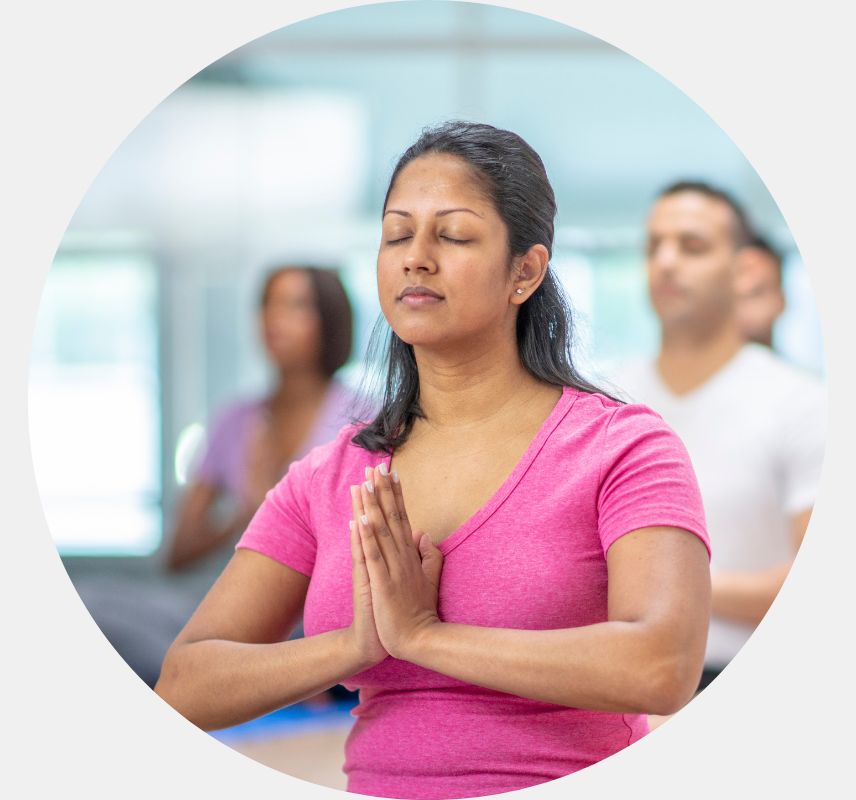
Have you ever thought about why all yoga and meditation teachers place so much importance on breathing? We know how important breathing is to sustain ourselves but what is so special about breathing during an exercise?
Conscious breathing or breathing with awareness of its rhythm can help in averting injuries during a yoga session, calm our minds and encourage the prana energy to flow fluidly. Physically, it will reduce joint compression and improve your postures. This is why you experience a ‘feel good’ factor when you complete a mindful breathing session in yoga.
In general, there are different ways of breathing and when they are practised in a systematic manner called breathing exercise. Now coming to yoga, breathing exercises are known as Pranayama and there are many types of pranayama one can do to see different effects on the body and mind.
The breathing technique that we will discuss today is the “Breath of Fire (BOF)”. In its simplest form, think BOF as the opposite of normal breathing; here your exhalation is rapid & active and inhalation is passive (less focused) keeping very little voluntary pause.
What is Breath of Fire?
Breath of Fire is a fast and rhythmic foundational breathing exercise of Kundalini Yoga wherein you are inhaling passively and exhaling actively.
It’s practised through the nostrils with mouth and eyes closes.
To exhale, you forcefully push the navel point in towards the spine and expel the air through the nostrils. Here you engage the core muscles to pull in and up the upper abdominal muscles. This feels automatic if you contract the diaphragm rapidly. Then with no pause after exhale, inhale; release the navel out, relax abdominal muscles and the diaphragm extends down.
Exhalation and inhalation in this way are rapid, rhythmic and in a continuous manner (Approximately 2-3 cycles per second.). It’s called Breath of Fire since continuous breathing strokes in this manner activates the solar plexus and generate a lot of internal heat in the body.
In the initial stages, you will have to practice this technique with full awareness of the ratio of breath by starting slow. However, gradually, you will be able to increase the speed (100 to 120 breaths per minute).
Breath of Fire gives a good workout to the abdomen muscles and also helps in generating inner heat, which in turn helps in detoxification and energizing your body. It also helps in improving digestion, reducing stress and anxiety, and enhancing respiratory functions.
Is Breath of Fire the same as Kapalabhati?
Most of the time Breath of Fire and Kapalbhati are used interchangeably. While Kapalabhati is also a form of Pranayama where you are doing forced exhalation but it should not be confused with Breath of Fire. However, to some extent, they are the same but in practice, there is a difference between them.
Breath of Fire focuses on making intentional equal lengths of inhale and exhale whereas in Kapalabhati the inhalation is an automatic response to the vacuum created by forceful breath.
Benefits of Breath of Fire
As we have already noted above, it is a great way to detoxify the organ systems, generate inner heat and energize your body and mind. There have been some scientific studies that have been done to suggest the benefits.
In 2014 [efn_note] Effect of Pranayama and Suryanamaskar on Pulmonary Functions in Medical Students https://www.ncbi.nlm.nih.gov/pmc/articles/PMC4316242/ [/efn_note] a study was conducted on 50 medical students in the 1st year of M.B.B.S. who were daily given 30 minutes of yoga training, including pranayam, for 2 months. It was found the controlled breathing technique helped improve the respiratory muscles and strengthens your diaphragm.
Another study conducted in 2013 [efn_note] Effect of fast and slow pranayama on perceived stress and cardiovascular parameters https://www.ncbi.nlm.nih.gov/pmc/articles/PMC3734635/ [/efn_note] showed a significant decrease in stress level and blood pressure amongst other parameters when participants were given fast breathing pranayama techniques like Breath of Fire.
A research conducted in 2017 [efn_note] Investigation of Yoga Pranayama and Vedic Mathematics on Mindfulness https://www.ncbi.nlm.nih.gov/pmc/articles/PMC5793008/ [/efn_note] studied the effects of Yoga Pranayama on 12th graders. It was found that students who were given training in pranayama showed positive results in increasing mindfulness.
A case report published in 2013 [efn_note] Can yoga be used to treat gastroesophageal reflux disease? https://www.ncbi.nlm.nih.gov/pmc/articles/PMC3734640/ [/efn_note] proved that fast breathing pranayama like Breath of Fire helped in reducing the symptoms of Gastroesophageal reflux disease
Here are some additional benefits:
- It helps in improving blood and oxygen circulation.
- Deep breathing helps in cleansing the organs and blood.
- The abdomen compression aids in digestion.
- Strengthens abdominal muscles and the area around the solar plexus.
- Enhances memory by improving focus and reducing stress.
- Creates a shield around your to protect you from negative energy by improving the magnetic field of the body.
- Expands the lung capacity
- Works on the immune system and parasympathetic nervous system.
- It creates harmony within the mind-body-spirit which can help in overcoming negative behavior and patterns.
- When done in conjunction with physical exercise, it enhances your endurance.
How to Do Breath of Fire
The important aspect of Breath of Fire is the length of breathing. Taking equal inhales and exhales, it should resemble a panting dog! It should be short and quick. Your inhale should expand your belly and during exhale, the tummy should contract all the way to the back. Make sure you are engaging the area around the navel and solar plexus, breathing through the nose, and are not pausing between the breaths.
It is done in a seated position and you should be aware of the breathing pattern rather than the speed of your breath. It is important that you do not lose focus on taking equal breathes in order to increase the speed, as it may cause a strain on your muscles.
Let us look at the step-by-step method to perform BOF.
- Start by sitting in a Padmasana, Sukhasana or Vajrasana. Sit tall with your back upright and chest opened.
- Place your palms on the knees, either in Chin Mudra or palms opens facing upwards. Alternatively, you can place your hands on your belly to feel your breathing.
- Take a few stable breaths to stabilize your body and remove distractions.
- Engage your belly and inhale through your nose. You should feel your belly and diaphragm expanding.
- Without any pause, exhale forcefully. Your abdomen and diaphragm should snap back into the spine.
- Make sure the length of inhale and exhale are equal. Establish a rhythm and repeat the process for at least 30 seconds.
- Over time, you can increase the time limit to 5-10 minutes.
Once you have finished practicing BOF, come back to the stable breathing, deep and slow inhales and exhales.
Common mistakes to avoid in doing Breath of Fire
While breath of fire is not an advanced technique that one needs to spend months mastering it, however, you must take care of the below things to practice BOF properly.
Paradoxical Breathing – In this type of breathing, practitioners pull in their bellies, which creates less space for the breath. This backward breathing can be a result of frequent smoking or anxiety. However, one can easily change this pattern by putting one hand on the abdomen and one on the chest to practice BOF in total awareness.
Targeting the lower belly instead of the diaphragm – The breath of fire images the area near the solar plexus, rather than the lower abdomen. You are not meant to exaggerate the filling of your lungs through this type of breathing technique. The idea is to control the intake and release of your breath.
By placing 3 fingers over the diaphragm, you can feel it moving back and forth with each breath you take. Also, to avoid muscle cramps on the abdomen, pause after 30 seconds to make sure you are not feeling sore or strained.
Not maintain training the pace and length of breath – If you are a beginner, you may forget to maintain the rhythm and ratio of the breathing technique. While practicing the rapid inhale and exhale, that mimics shallow breathes, you may feel lightheaded. At this moment, stop performing BOF and return to take long deep breathes.
You need to keep the length of inhale and exhale equal. Start by practising it at a slower pace and gradually build the pace. If your inhale is more, you may feel nauseated or loopy and if your exhale is longer, you may be deprived of oxygen and feel dizzy.
Frequently Asked Questions
Beginners should start by performing this pranayama technique for 30 seconds. This is done to see if you experience any severe strain in your abdomen. With regular practice, you can increase this time to 10-15 minutes. Also, practicing BOF for 5-15 minutes a day helps to purify the blood.
Initially, target 1 round of breathing cycle per second which will increase to 2-3 cycles of breathing per second.
While any pranayama is safe to perform however there are some exceptions to this. If you are a woman who is pregnant or is menstruating, you should avoid doing this practice. It is should also be avoided if you are under 16 years of age, have problems with breathing, are suffering from a heart condition, or have a spinal problem.
You may experience dizziness, giddiness, or lightheadedness however that is a common symptom of fast breathing. The moment you feel uncomfortable, you should immediately stop the practice and take deep slow breaths. If you are new to this, do not try to perform BOF for an extended time at once.
Conclusion
By making the Breath of Fire a part of your daily routine to remove all stress and anxiety in life. It has some amazing benefits which you will be able to see through regular practice. Start slowly and gradually increase your time because good things come with patience.




